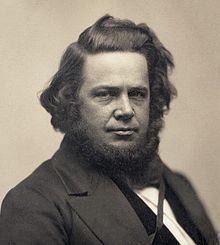Elias Howe

Elias Howe (born July 9, 1819 in Spencer , Massachusetts , † October 3, 1867 in Brooklyn ) was an American mechanical engineer and inventor.
Life
Elias Howe showed great interest in machines and technical processes even in his childhood. After finishing school, he began to learn machine craft. After training in the profession, he worked in a cotton mill in Lowell from 1835 to 1837, and later in Cambridge and Boston. Here he was already with his attempts to construct a usable sewing machine, the two-thread sewing machine. He worked on the basic idea for five years, devoting almost all of his free time to it, but with this machine he managed 300 stitches per minute. In contrast, seamstresses who worked by hand only managed 50 stitches per minute. Other tinkerers had previously designed machines, but their technical defects and the high price prevented them from being used in industry. Howe's machine was also $ 300, quite a high price that tailors couldn't pay. In addition, Howe's machine only made straight seams, everything else still had to be sewn by hand.
Now Elias Howe pursued the goal of further improving the machine, introduced the single-point needle, which has the eye very close to its point, only let it go into the fabric just above the eye and form a loop when it goes back a second thread was guided with the help of the shuttle (which Hunt had used before him ). Funded by his friend Fisher, he completed this machine in 1845 and had it patented in America on September 10, 1846 in his name until 1867 . His brother Amasa Howe took this sewing machine to London and sold it for 250 engl. Pound to William Thomas, who immediately recognized its true value and had it provided with an English patent in 1846.
However, since Howe was unsuccessful in America, he also tried to gain a foothold in the textile industry in England and to further specialize his sewing machine. Above all, it was important to him that the machine could also sew leather and other solid materials. For his livelihood he also worked in a factory for only 5 English. Pounds a week. But when his financial situation continued to deteriorate, he at least sent his family back to the United States. Completely impoverished, Elias Howe returned to America in 1850 and set up a small workshop in New York . In the meantime, Singer had started production of the sewing machine in New York, with significant use of Howe's construction team. When Howe found out, he filed a lawsuit and won the multi-year lawsuit against Singer . From then on his factory flourished. In 1854 he also received the payments due to him for the sewing machines manufactured by Singer in the USA until his patent expired in 1867.
In 1851 he patented an automatic, uninterrupted clothing fastener , the forerunner of the modern zipper .
Howe later joined the US Army as a soldier . When he died in Brooklyn on October 3, 1867, aged only 48, he left a very large fortune. In 1870, 75,156 machines were built according to Howes' system.
In 1965 the Beatles dedicated their film Hi-Hi-Hilfe to him.
literature
- The story of a house friend . In: The Gazebo . Issue 31, 1867 ( full text [ Wikisource ]).
Web links
- Patent Office Stories
- Inventor of the first American-patented sewing machine
- Patents & Talents: Mr. Howe's sewing machine . einsplus.de; Broadcast from January 14, 2012, 11.30 a.m. - 12.00 p.m. (30 min.)
Individual evidence
- ^ Hermann Grothe, Pictures and Studies for the History of Industry and Mechanical Engineering , Berlin 1870, p. 374.
- ↑ see e.g. B. Bill Bryson : Made in America: an Informal History of the English Language in the United States . Black Swan, 1998, ISBN 0-552-99805-2 , p. 110.
- ↑ Amy Tikhanen, biography about Elias Howe, Encyclopedia Britannica, in: http://www.britanica.com/Biographie/Elias-Howe
| personal data | |
|---|---|
| SURNAME | Howe, Elias |
| BRIEF DESCRIPTION | American manufacturer and inventor of a sewing machine |
| BIRTH DATE | July 9, 1819 |
| PLACE OF BIRTH | Spencer , Massachusetts |
| DATE OF DEATH | October 3, 1867 |
| PLACE OF DEATH | Brooklyn |


